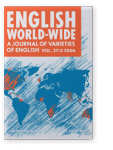Vol. 27:2 (2006) ► pp.217–227
Cameroon Pidgin and Cameroon English at a confluence
A real-time investigation
The paper argues that Cameroon Pidgin, a simplified language that displayed a unique peculiarity in the yesteryears, is now giving up most of its phonological peculiarities and embracing those of the variety of English spoken in Cameroon. An analysis of the speech of 150 educated Cameroon Pidgin speakers, randomly selected, shows that such phonological processes as heavy infiltration of sounds from indigenous Cameroonian languages, rampant consonant cluster simplification through vowel epenthesis and other segmental peculiarities which characterized Cameroon Pidgin by 1960, as depicted in Schneider (1960), are by far less perceivable in current Cameroon Pidgin usage. It is demonstrated that the feeling that Pidgin is an inferior language has caused Cameroon Pidgin speakers to opt for the “modernization” of the language using English language canons, instead of preserving the state of the language as it was in the yesteryears. It is therefore predicted that Cameroon Pidgin and Cameroon English will sooner or later be in a continuum.
Cited by
Cited by 8 other publications
This list is based on CrossRef data as of 2 july 2024. Please note that it may not be complete. Sources presented here have been supplied by the respective publishers. Any errors therein should be reported to them.
